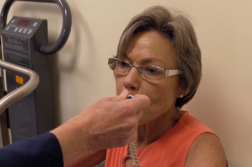TAMPA, Fla. (Ivanhoe Newswire) — The thyroid is a small gland in the front of your neck and it happens to be a favorite target for cancer. According to the American Cancer Society, thyroid cancer cases have tripled in the last three decades. The good news: it’s treatable. There are symptoms you need to watch out for … especially if you’re a woman.
The lump behind her ear was enough to get Laura Bruser concerned.
Laura shared, “I went to an ENT doctor. He did a cat scan. Turns out I had nothing here, but they found a nodule on my thyroid.”
After she processed the fact it was cancer, the next tough hurdle was explaining it to her eight year old son.
Laura continued, “He just looked at me and said, ‘Mommy, are you going to lose your hair?’ and, I said, ‘No, I’m not honey. It’s not that kind of cancer.’”
Bruser is among a growing number of women diagnosed with thyroid cancer which has tripled over the past 30 years. The doctor treating Bruser is considered one of the best thyroid surgeons in the world, Gary Clayman, MD, Tampa General Hospital, Founder, The Thyroid and Parathyroid Institute.
Dr. Clayman says, “If you’re a woman and you live long enough, you will develop thyroid nodules. Not necessarily thyroid cancer because most thyroid nodules are not cancerous.”
The American Cancer Society reports that women are diagnosed three times more often than men.
“They took out my whole thyroid. I had three nodules and they took out 22 lymph nodes as well,” stated Laura.
While it’s unknown why cases are increasing among women and there’s no way to prevent it, Dr. Clayman says most thyroid cancers don’t need to be treated right away because they’re not life-threatening. Additonally …
“Ninety to 95 percent of thyroid surgeries are performed in the country by highly inexperienced thyroid surgeons,” continued Dr. Clayman.
Bruser’s symptoms were clear … pain in the front of her neck and trouble breathing.
“I was having problems swallowing and I was having horrible sleep issues,” said Laura.
Only days after her surgery, Bruser was in the jingle bell run with her husband and son.
“We did that as a family, seven days after, so that felt great,” Laura said smiling.
If you do end up needing surgery for thyroid cancer, the scar is very minimal. Dr. Clayman says you can live with thyroid nodules and never have cancer but definitely discuss it with an endocrinologist.
Contributors to this news report include: Sarah Rosario, Producer; Roque Correa, Editor and Angela Clooney, Videographer.
Free weekly e-mail on Medical Breakthroughs from Ivanhoe. To sign up: http://www.ivanhoe.com/ftk
THYROID CANCERS TRIPLE!
REPORT #2536
BACKGROUND: This year, approximately 56,870 adults in the United States will be diagnosed with thyroid cancer. Of those, 14,400 are men and 42,470 are women. Thyroid cancer is the fifth most common cancer in women ages 20 to 34. About 2 percent of cases occur in children and teens. The incidence rates of thyroid cancer in both women and men have been increasing in recent years, at a rate of about 5 percent more a year. In fact, it is the most rapidly increasing cancer diagnosis in the United States. Researchers believe that part of the reason for the increase is that newer, highly sensitive diagnostic tests are leading to increased detection of smaller cancers. Around 2,010 deaths (920 men and 1,090 women) from this disease will occur this year. Women are 3 times more likely to have thyroid cancer than men, but death rates among women and men are similar. This suggests that men have a worse prognosis than women when there is a diagnosis of thyroid cancer. Prognosis means the chance of recovery. Overall, the 5 year survival rate for people with thyroid cancer is 98 percent.
(Source: https://www.cancer.net/cancer-types/thyroid-cancer/statistics)
SYMPTOMS AND TREATMENT: Your thyroid is a butterfly-shaped gland at the base of your throat. It’s involved in some very big jobs, like managing your heart rate, blood pressure, body temperature, and weight. Your thyroid has two lobes, left and right, that are connected by a thin piece of tissue. If it’s healthy, each lobe is about the size of a quarter and you won’t see or feel it under your skin. If cancer forms in your thyroid gland, you may have symptoms like trouble swallowing, difficulty breathing, hoarseness or other voice changes, a constant cough that is not due to a cold, a lump in the front of the neck (around the Adam’s apple) that might grow quickly, or swollen (but not painful) glands in the neck. There are some common methods to treat thyroid cancer. Surgery is the most widely used method to get rid of thyroid cancer. It’s called a thyroidectomy. All or part of your thyroid gland is removed in this procedure. Radioactive iodine (RAI) ablation is used to destroy any thyroid tissue that’s left after a thyroidectomy. The iodine goes to the thyroid tissue and the radiation destroys it. If all of your thyroid gland is removed, you’ll take thyroid hormone pills for the rest of your life. The pills also help stop leftover cancer cells from growing and returning.
(Source: https://www.webmd.com/cancer/thyroid-cancer-symptoms and https://www.webmd.com/cancer/thyroid-cancer-treatments)
TARGETED THERAPY RESEARCH: Two immunotherapy drugs currently approved by the U.S. Food and Drug Administration for the treatment of melanoma also show promise for treating a rare but aggressive form of papillary thyroid cancer. Up to 44 percent of papillary thyroid cancer patients have a B-raf mutation that can be specifically targeted by existing cancer drugs. The B-raf gene belongs to a class of genes known as “oncogenes,” which send signals to normal cells that cause them become cancerous. B-raf gene mutations have known roles in the development of many human cancers including melanoma, lung and thyroid cancer.
In a randomized, phase 2 multi-center clinical study, researchers tested the effectiveness of the targeted therapy drug, dabrafenib, given alone compared with the same drug given in combination with trametinib, to treat a subset of advanced papillary thyroid cancer patients with B-raf mutations. “This is an entirely new approach to treating a disease that has limited treatment options. There is no clear winner between single and dual agent targeted therapy yet but the good news is that both therapy approaches resulted in positive outcomes for patients,” said Manisha Shah, MD of The Ohio State University Comprehensive Cancer Center.
(Source: https://www.sciencedaily.com/releases/2017/06/170605133533.htm)
* For More Information, Contact:
Gary L. Clayman, MD Ellen Fiss, Tampa General Public Relations
clayman@thyroidcancer.com (813) 844-6397



